Spatiotemporal Coupling Factors and Mode of Tourism Industry, Urbanization and Ecological Environment: A Case Study of Shaanxi, China
Abstract
1. Introduction
2. Theoretical Basis and Literature Review
2.1. Coupling Mechanism between the Tourism Industry-Urbanization and Ecological Environment
2.2. Coupling between Tourism Industry and Urbanization
2.3. Coupling between Tourism Industry and Ecological Environment
2.4. Coupling of Tourism Industry-Urbanization-Ecological Environment
2.5. Research Review
3. Study Area
4. Methods and Data
4.1. Methods
4.1.1. Evaluation Model for Comprehensive Development Level
4.1.2. Evaluation Model for Coupling Degree
4.1.3. Evaluation Model for Coupling Coordination Degree
4.1.4. Interval Division of Coupling Coordination Degrees
4.2. Evaluation Index
4.3. Data Sources
5. Results
5.1. Time Evolution Characteristics of Tourism Industry-Urbanization-Ecological Environment Coupling
5.2. Spatial Pattern Evolution of Tourism Industry-Urbanization-Ecological Environment Coupling
5.3. Influencing Factors of Tourism Industry-Urbanization-Ecological Environment Coupling and Their Evolution
5.4. Development Modes of Tourism Industry-Urbanization-Ecological Environment Coupling and Their Evolution
6. Discussion
7. Conclusions
Author Contributions
Funding
Conflicts of Interest
References
- Freya, H.D. Sustainable tourism: Sustaining tourism or something more? Tour. Manag. Perspect. 2018, 25, 157–160. [Google Scholar]
- Gao, Y.; Ma, Y.F.; Liu, J.S. Study on the coupling coordinative development and types among tourism, urbanization and ecological system: A case study of Beijing-Tianjin-Hebei. J. Shaanxi Norm. Univ. (Nat. Sci. Ed.) 2016, 44, 109–118. [Google Scholar]
- Ma, Y.F.; Zhang, C.H.; Liu, J.S.; Gao, Y.; Pang, W. Coupling with Tourism: A New Approach to Sustainable Development Research. Tour Hospit Prosp. 2018, 2, 1–19. [Google Scholar]
- Liu, J.S.; Ma, Y.F. The evolution and driving mechanism of the supply and demand coupling about tourism flow and destination system based on the genesis and system theory: Taking Xi’an as an example. Geogr. Res. 2017, 36, 1583–1600. [Google Scholar]
- Ministry of Culture and Tourism of the People’s Republic of China. The Yearbook of China Tourism Statistics; China Tourism Press: Beijing, China, 2018.
- Mullins, P. Tourism Urbanization. Int. J. Urban Reg. Res. 1991, 15, 326–342. [Google Scholar] [CrossRef]
- Murphy, C.; Boyle, E. Testing a conceptual model of cultural tourism development in the post-industrial city: A case study of Glasgow. Tour. Hosp. Res. 2006, 6, 111–128. [Google Scholar] [CrossRef]
- Yin, M.; Xu, J.G.; Yang, Z.Y. Preliminary Research on Planning of Decentralizing Ancient Towns in Small-Scale Famous Historic and Cultural Cities with a Case Study of Tingchow County, Fujian Province. Sustainability 2019, 11, 2911. [Google Scholar] [CrossRef]
- Tang, W.; Zhou, T.C.; Sun, J. Accelerated Urban Expansion in Lhasa City and the Implications for Sustainable Development in a Plateau City. Sustainability. 2017, 9, 1499. [Google Scholar] [CrossRef]
- Akama, J.; Kieti, D. Tourism and socio-economic development in developing countries: A case study of Mombasa Resort in Kenya. J. Sustain. Tour. 2007, 15, 735–748. [Google Scholar] [CrossRef]
- Yi, P.; Zhai, M.Y.; Lin, L. Characterizing the spatiotemporal evolutions and impact of rapid urbanization on island sustainable development. Habitat Int. 2016, 53, 215–227. [Google Scholar]
- Gao, N.; Ma, Y.F.; Li, T.S.; Bai, K. Study on the Coordinative Development between Tourism Industry and Urbanization Based on Coupling Model: A Case Study of Xi’an. Tour. Trib. /Lvyou Xuekan. 2013, 28, 62–68. [Google Scholar]
- Zhan, X.H.; Ma, Y.F.; Gao, N.; Guo, Z.Z. Analysis on spatial and temporal characteristics of the coupling coordination evolution between regional urbanization and tourism: A case study of Shannxi province. J. Shaanxi Norm. Univ. (Nat. Sci. Ed.) 2014, 42, 82–87. [Google Scholar]
- Ma, L.; Cheng, W.; Qi, J. Coordinated evaluation and development model of oasis urbanization from the perspective of new urbanization: A case study in Shandan County of Heixi Corridor, China. Sustain. Cities Soc. 2018, 39, 78–92. [Google Scholar] [CrossRef]
- Marjo, N.; Eija, P.; Jenni, P. Visits to national parks: Effects of park characteristics and spatial demand. J. Nat. Conserv. 2010, 18, 393–407. [Google Scholar]
- Tang, Z. An integrated approach to evaluating the coupling coordination between tourism and the environment. Tour. Manag. 2015, 46, 11–19. [Google Scholar] [CrossRef]
- Jones, C.; Munday, M. Exploring the environmental consequences of Tourism: A satellite account approach. J. Travel Res. 2007, 46, 164–172. [Google Scholar] [CrossRef]
- Stroma, C. A political ecology of water equity and tourism a case study from bali. Ann. Tour. Res. 2012, 39, 1221–1241. [Google Scholar]
- Hsin, J.H.; Shiann, F.K. The linkage analysis of environmental impact of tourism industry. Procedia Environ. Sci. 2013, 17, 658–665. [Google Scholar]
- Holden, A. Tourism and the Green Economy: A Place for an Environmental Ethic? Tour. Recreat. Res. 2013, 38, 3–13. [Google Scholar]
- Elisa, M.; Fabio, P.; Rocco, S. A forest ecosystem services evaluation at the river basin scale: Supply and demand between coastal areas and upstream lands (Italy). Ecol. Indic. 2014, 37, 210–219. [Google Scholar]
- Rahmani, A.; Fakhraee, A.; Karami, S. A Quantitative Approach to Estimating Carrying Capacity in Determining the Ecological Capability of Urban Tourism Areas (Case Study: Eram Boulevard of Hamadan city). Asia Pac. J. Tour. Res. 2015, 20, 1–15. [Google Scholar] [CrossRef]
- Fery, K.; Luky, A.; Dietriech, G.B.; Lilik, B.P. The social-ecological status of small islands: An evaluation of island tourism destination management in Indonesia. Tour. Manag. Perspect. 2019, 31, 136–144. [Google Scholar]
- Gao, W.Q.; Wang, Y.X. Research on Coupling Coordinative Degree between Tourism Industry and Ecological Environment of Changshan Islands. Areal Res. Dev. 2017, 36, 103–107. [Google Scholar]
- Wang, Z.F.; Huo, F.F.; Xu, S. Study on coupled development and regional differences between tourism industry and tourism environments in Hunan, Hubei, Chongqing and Guizhou. Econ. Geogr. 2018, 38, 204–213. [Google Scholar]
- Nie, X.Y.; Shi, P.J.; Wang, X.M. Data Processing in Ecological Development and Environment Improvement by Analysis of the Relationship between Tourism Development and Urban Development. Adv. Mater. Res. 2014, 978, 169–173. [Google Scholar] [CrossRef]
- Han, W.Y.; Chen, X.P.; Pang, J.X.; Wang, N.F.; Yu, Y.H. Coupling coordination development amidst the urbanization-ecological environment-tourism industry: Taking nine provinces and cities on the Silk Road Economic Belt as an example. J. Lanzhou Univ. Nat. Sci. 2018, 54, 762–769. [Google Scholar]
- Liao, K.C.; Ming, Y.Y.; Sun, S.W. An Evaluation of Coupling Coordination between Tourism and Finance. Sustainability 2018, 10, 2320. [Google Scholar] [CrossRef]
- Hu, Z.P.; Huang, X.X.; Fu, C.; Yu, D.J. The quantitative comparison and evolutionary analysis on interactive coupling among tourism, urbanization, ecological environment in Poyang lake area. Resour. Environ. Yangtze Basin. 2015, 24, 2012–2020. [Google Scholar]
- Xu, H.Y.; Zheng, H.D.; Wu, L. Analysis on coupling coordination of tourism industry, urbanization, ecological environment: A case study of six provinces along the middle and lower reaches of the Yangtze river. J. Fujian Agric. For. Univ. (Philos. Soc. Sci.) 2017, 20, 84–92. [Google Scholar]
- Li, X. A Study on the spatial and temporal differentiation of tourism industry urbanization ecological Environment Coordination in Yangtze River Economic Zone. Ecol. Econ. 2017, 33, 115–120. [Google Scholar]
- Chen, Q.S. Study on the Evaluation of Coordination Degree about Urban Tourism Supply and Demand. Master’s Thesis, Shaanxi Normal University, Xi’an, China, 11 June 2015. [Google Scholar]
- Martin, R.; Sunley, P. Path dependence and regional economic evolution. J. Econ. Geogr. 2006, 6, 395–437. [Google Scholar] [CrossRef]
- He, C.F. Regional industrial development and evolution: Path dependence or path creation? Geogr. Res. 2018, 37, 1253–1267. [Google Scholar]
- Yan, Y.Y.; An, H.S. Evolutionary economic geography: The second bridge between economics and geography. Prog. Geogr. 2013, 32, 788–796. [Google Scholar]
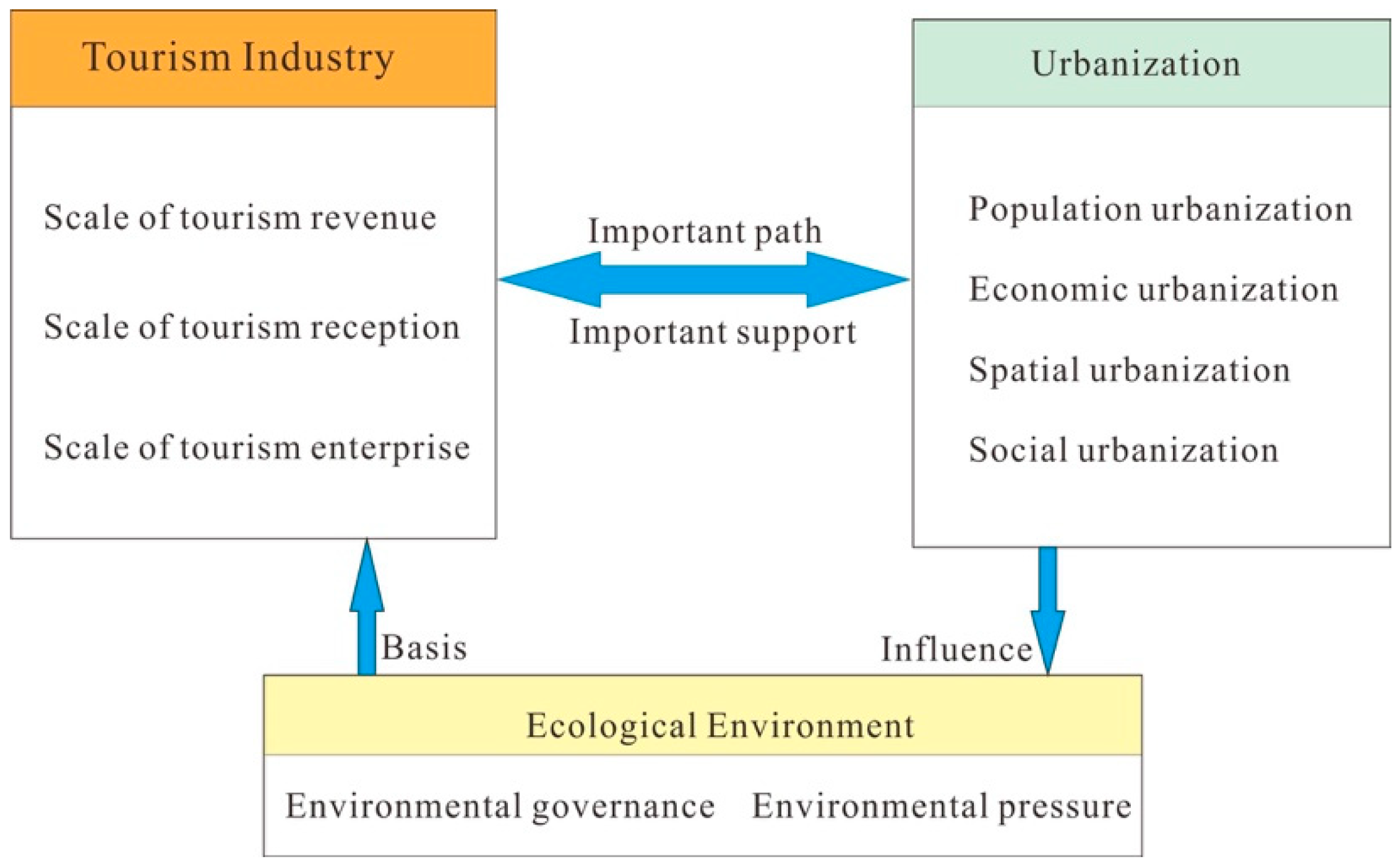
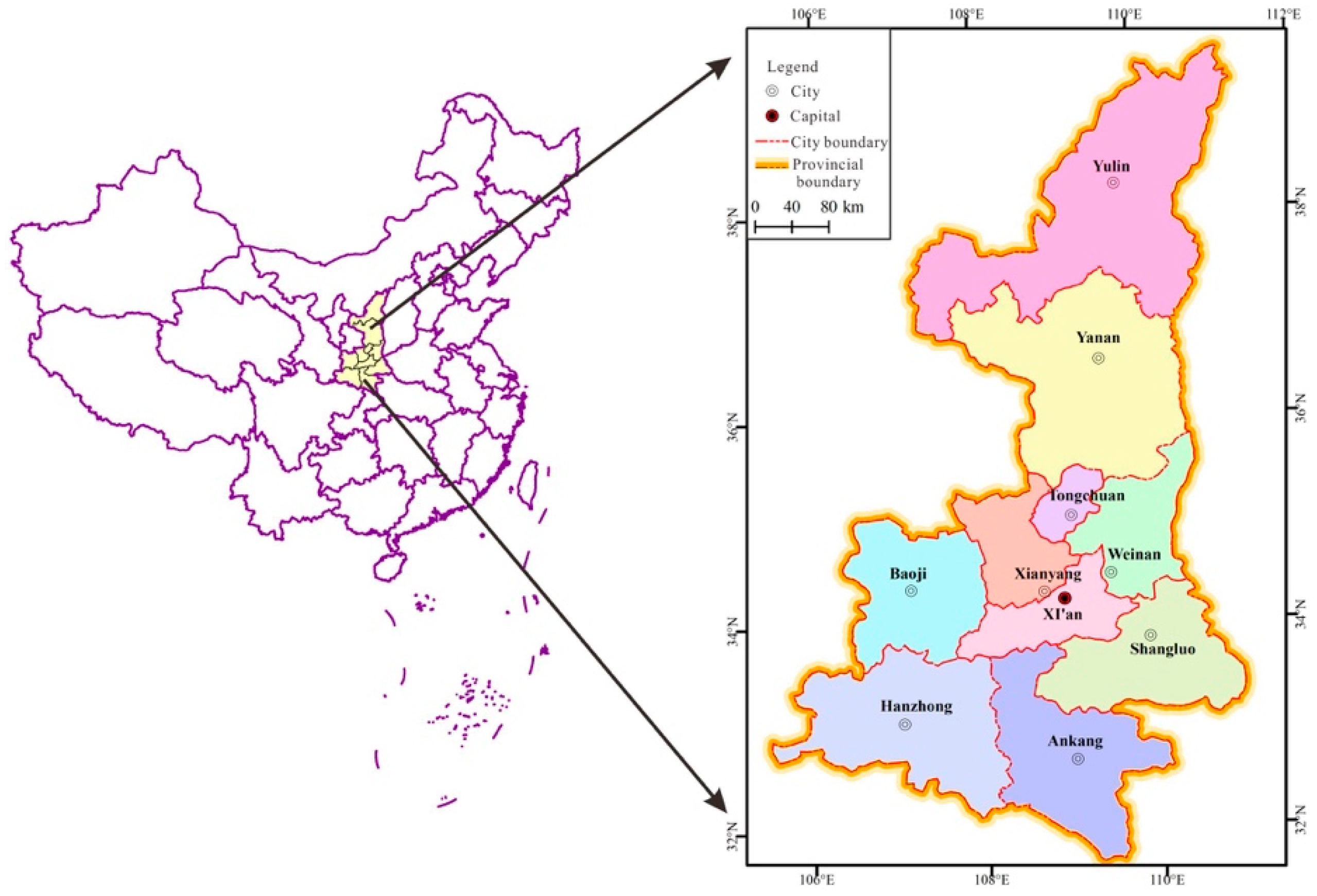
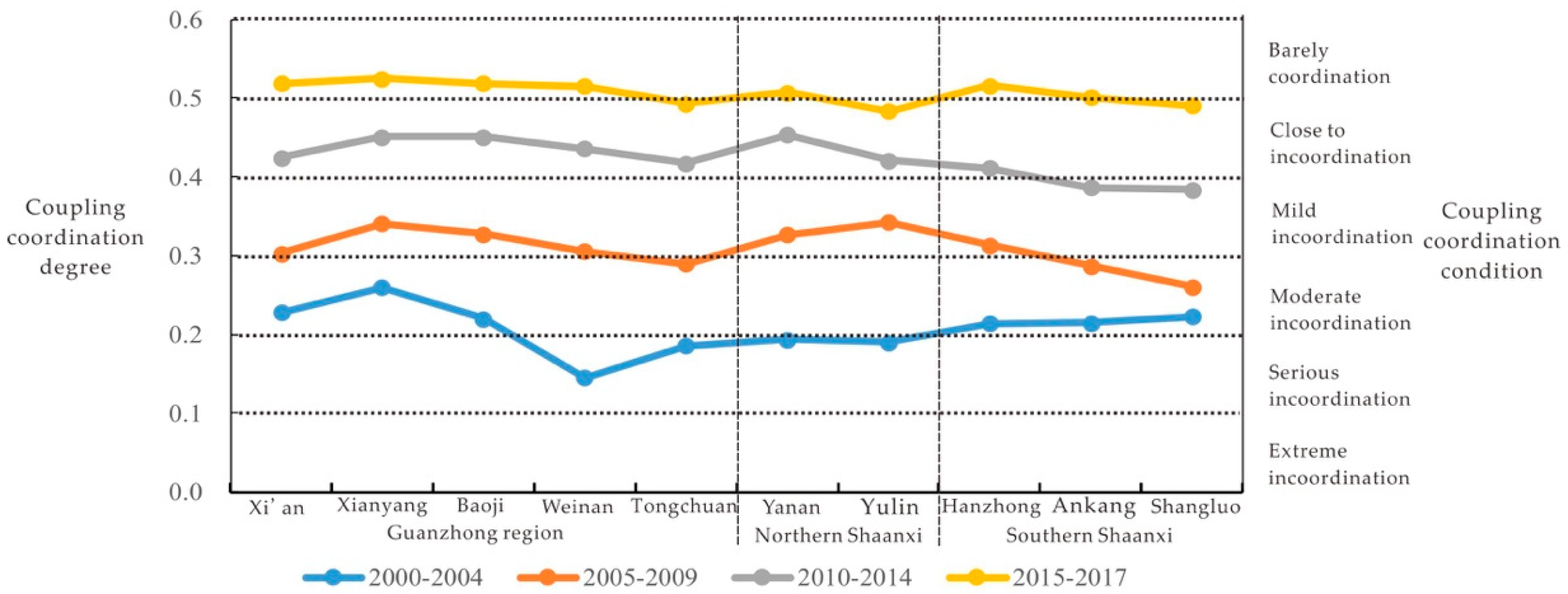
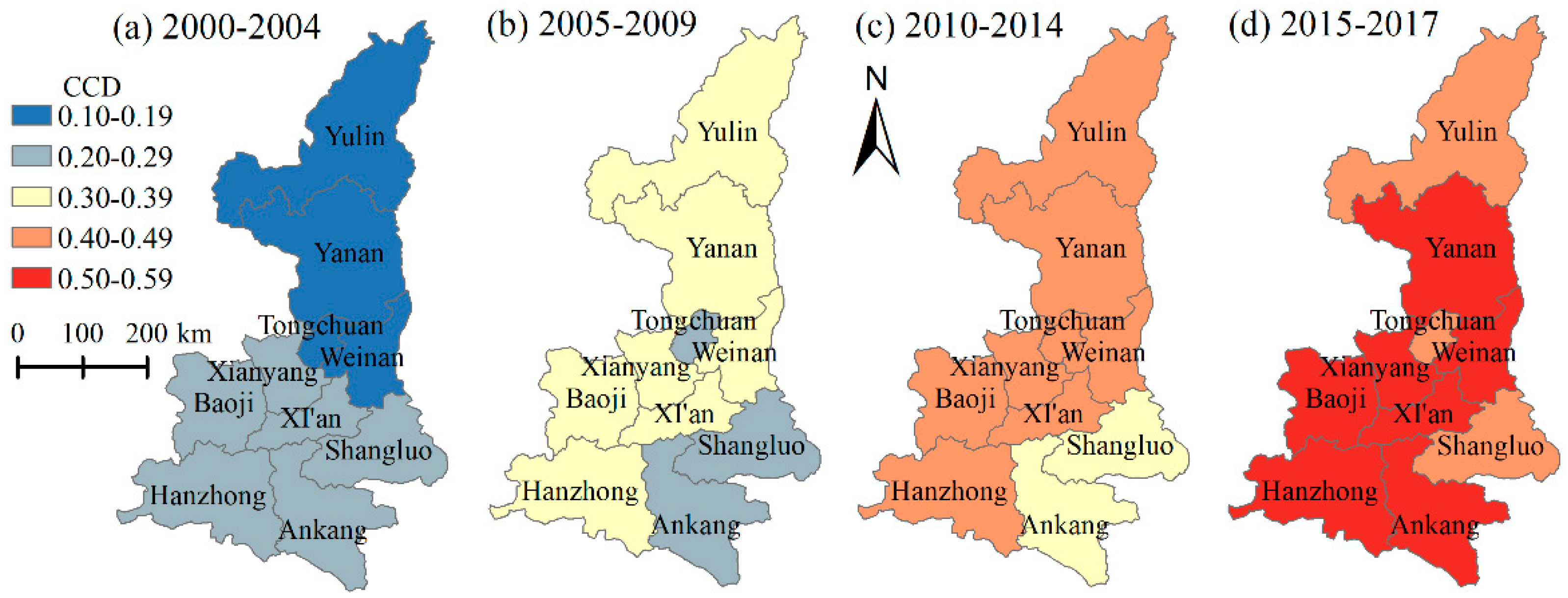
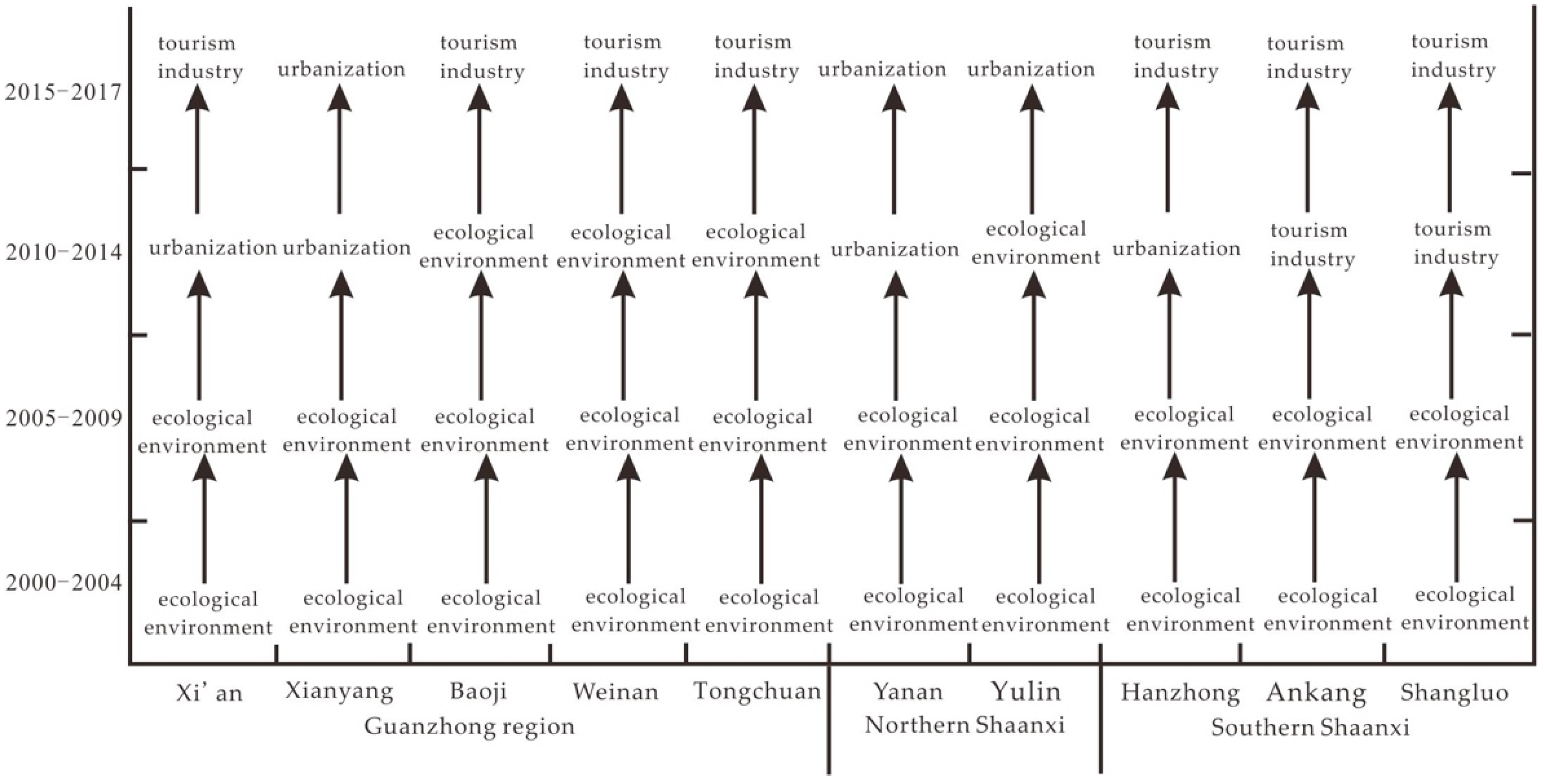
| Coordination Degree (D) | Coordination Level | Coordination Degree (D) | Coordination Level |
|---|---|---|---|
| 0.00–0.09 | Extreme incoordination | 0.50–0.59 | Barely coordination |
| 0.10–0.19 | Serious incoordination | 0.60–0.69 | Primary coordination |
| 0.20–0.29 | Moderate incoordination | 0.70–0.79 | Intermediate coordination |
| 0.30–0.39 | Mild incoordination | 0.80–0.89 | Good coordination |
| 0.40–0.49 | Close to incoordination | 0.90–1.00 | Quality coordination |
| Systems | Elements | Indexes | Types |
|---|---|---|---|
| Tourism Industry | Scale of tourism reception | Number of international tourists/10,000 people | + |
| Number of domestic tourists/10,000 people | + | ||
| Scale of tourism revenue | International tourism revenue/10,000 yuan | + | |
| Domestic tourism revenue/10,000 yuan | + | ||
| Ratio of total tourism revenue to tertiary industry revenue/% | + | ||
| Size of tourism enterprise | Number of star-rated hotels | + | |
| Number of travel agencies | + | ||
| Number of scenic spots | + | ||
| Urbanization | Population urbanization | Urban population density/(people·km2) | + |
| Proportion of urban population/% | + | ||
| Natural growth rate of urban population/% | + | ||
| Total employed population/10,000 people | + | ||
| Economic urbanization | Per capita GDP/10,000 yuan | + | |
| Proportion of secondary industry in GDP/% | + | ||
| Proportion of tertiary industry in GDP/% | + | ||
| Urban residents’ disposable income/10,000 yuan | + | ||
| Social urbanization | Fixed asset investment/100 million yuan | + | |
| Student enrolment in ordinary institutions of higher learning | + | ||
| Total water supply/10,000 cubic meters | + | ||
| Total gas supply/10,000 cubic meters | + | ||
| Civil vehicle ownership/unit | + | ||
| Number of health technical personnel/person | + | ||
| Spatial urbanization | Urban construction land area/km2 | + | |
| Per capita urban housing area/m2 | + | ||
| Per capita urban road area/m2 | + | ||
| Ecological Environment | Environmental control | Green coverage in built-up areas/% | + |
| Per capita park green area/m2 | + | ||
| Green area/10,000 hectares | + | ||
| Green area in built-up areas/10,000 hectares | + | ||
| Percentage of sewage disposal/% | + | ||
| Harmless disposal rate of household garbage/% | + | ||
| Comprehensive utilization rate of industrial solid waste/% | + | ||
| Environmental pressure | Industrial wastewater discharge/10,000 t | − | |
| Industrial waste gas emissions/10,000 t | − | ||
| Industrial solid waste emissions/10,000 t | − |
| City | 2000–2004 | 2005–2009 | 2010–2014 | 2015–2017 |
|---|---|---|---|---|
| Xi’an | scale of tourism revenue, economic urbanization, environmental control, environmental pressure | size of tourism enterprise, economic urbanization, spatial urbanization, environmental control | size of tourism enterprise, economic urbanization, spatial urbanization, environmental control | scale of tourism reception, size of tourism enterprise, population urbanization, spatial urbanization, environmental control |
| Xian Yang | scale of tourism reception, economic urbanization, environmental control, environmental pressure | size of tourism enterprise, social urbanization, spatial urbanization, environmental control, environmental pressure | scale of tourism reception, size of tourism enterprise, population urbanization, spatial urbanization, environmental control | scale of tourism revenue, social urbanization, spatial urbanization, environmental control |
| Baoji | size of tourism enterprise, population urbanization, economic urbanization, environmental control, environmental pressure | size of tourism enterprise, population urbanization, spatial urbanization, environmental control, environmental pressure | scale of tourism reception, size of tourism enterprise, population urbanization, spatial urbanization, environmental control | scale of tourism reception, scale of tourism revenue, population urbanization, social urbanization, spatial urbanization, environmental control |
| Wei Nan | social urbanization, environmental control, environmental pressure | size of tourism enterprise, population urbanization, spatial urbanization, environmental control, environmental pressure | scale of tourism revenue, economic urbanization, social urbanization, spatial urbanization, environmental control | scale of tourism revenue, scale of tourism reception, size of tourism enterprise, social urbanization, spatial urbanization, environmental control |
| Thong Chuan | size of tourism enterprise, population urbanization, economic urbanization, environmental control, environmental pressure | scale of tourism reception, size of tourism enterprise, economic urbanization, spatial urbanization, environmental control, environmental pressure | scale of tourism reception, size of tourism enterprise, economic urbanization, spatial urbanization, environmental control | scale of tourism revenue, scale of tourism reception, economic urbanization, social urbanization, environmental control |
| Yulin | economic urbanization, environmental control, environmental pressure | size of tourism enterprise, spatial urbanization, economic urbanization, environmental control, environmental pressure | scale of tourism reception, size of tourism enterprise, population urbanization, spatial urbanization, environmental control | scale of tourism reception, population urbanization, social urbanization, spatial urbanization, environmental control |
| Yanan | economic urbanization, spatial urbanization, environmental control, environmental pressure | size of tourism enterprise, economic urbanization, spatial urbanization, environmental control, environmental pressure | scale of tourism reception, scale of tourism revenue, economic urbanization, social urbanization, environmental control | size of tourism enterprise, population urbanization, social urbanization, environmental control |
| Han Zhong | population urbanization, economic urbanization, environmental pressure | size of tourism enterprise, population urbanization, spatial urbanization, environmental control, environmental pressure | size of tourism enterprise, economic urbanization, population urbanization, environmental control | scale of tourism revenue, scale of tourism reception, size of tourism enterprise, spatial urbanization, environmental control |
| Ankang | economic urbanization, population urbanization, environmental control, environmental pressure | size of tourism enterprise, population urbanization, economic urbanization, environmental control | scale of tourism revenue, size of tourism enterprise, economic urbanization, population urbanization, environmental control | scale of tourism revenue, scale of tourism reception, size of tourism enterprise, economic urbanization, spatial urbanization, environmental control |
| Shang Luo | economic urbanization, spatial urbanization, environmental pressure | scale of tourism reception, economic urbanization, spatial urbanization, environmental pressure, environmental control | scale of tourism reception, scale of tourism revenue, economic urbanization, spatial urbanization, environmental control | scale of tourism revenue, scale of tourism reception, size of tourism enterprise, spatial urbanization, environmental control |
© 2019 by the authors. Licensee MDPI, Basel, Switzerland. This article is an open access article distributed under the terms and conditions of the Creative Commons Attribution (CC BY) license (http://creativecommons.org/licenses/by/4.0/).
Share and Cite
Liu, J.; Li, C.; Tao, J.; Ma, Y.; Wen, X. Spatiotemporal Coupling Factors and Mode of Tourism Industry, Urbanization and Ecological Environment: A Case Study of Shaanxi, China. Sustainability 2019, 11, 4923. https://doi.org/10.3390/su11184923
Liu J, Li C, Tao J, Ma Y, Wen X. Spatiotemporal Coupling Factors and Mode of Tourism Industry, Urbanization and Ecological Environment: A Case Study of Shaanxi, China. Sustainability. 2019; 11(18):4923. https://doi.org/10.3390/su11184923
Chicago/Turabian StyleLiu, Junsheng, Cui Li, Jinqing Tao, Yaofeng Ma, and Xiaojin Wen. 2019. "Spatiotemporal Coupling Factors and Mode of Tourism Industry, Urbanization and Ecological Environment: A Case Study of Shaanxi, China" Sustainability 11, no. 18: 4923. https://doi.org/10.3390/su11184923
APA StyleLiu, J., Li, C., Tao, J., Ma, Y., & Wen, X. (2019). Spatiotemporal Coupling Factors and Mode of Tourism Industry, Urbanization and Ecological Environment: A Case Study of Shaanxi, China. Sustainability, 11(18), 4923. https://doi.org/10.3390/su11184923




